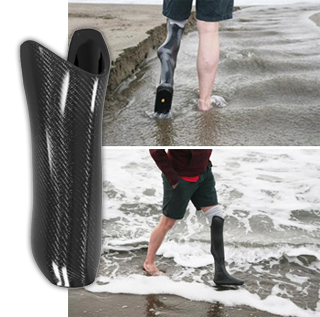|
Orthologix brings you quarterly information to keep you current on industry news, trends and insights. Orthologix is an orthotics and prosthetics practice delivering evidence-based care throughout the Delaware Valley.

FEATURED PRODUCT 
Standard Cyborg - Waterproof Prosthesis
Normal prostheses are not designed to get wet, whether in the shower, pool, or ocean. There are shower/swim prostheses on the market, but often the cost of obtaining one is not covered by insurance, and too expensive for the patient's budget.
But a new option is available. An entrepreneur with a background in industrial engineering founded a company called Standard Cyborg, which manufactures custom waterproof leg prostheses - the Water Leg - through a 3D printing manufacturing process.
3D printing also known as additive manufacturing is any of various processes used to make a three-dimensional object. In 3D printing, additive processes are used, in which successive layers of material are laid down under computer control. These objects can be of almost any shape or geometry, and are produced from a 3D Model or other electronic data source.
At Standard Cyborg, the process begins either working with a client's prosthetist or directly with the client to get the exact dimension of their current prosthetic device. It is modeled and sent to a high-end 3D printer to get fabricated. Then, an aerospace-grade carbon fiber material coating is added to ensure the strength and safety of the device for the amputee wearing it. All Standard Cyborg's prosthetics are custom-made; the final lamination process takes two hours and is done by hand.
It is 100 percent waterproof, dries quickly, and has a Vibram non-slip sole.
While first designed as a shower leg, it can be used in sandy and salty conditions. Its easy donning and doffing means it also facilitates middle of the night trips to the bathroom. The Water Leg can be put on in under 10 seconds, making it the perfect device for doing quick simple tasks around the house, avoiding the need to put on a more time-consuming prosthetic.
Back to top

PROFILE
 Jeff Huber
Jeff Huber
Jeff Huber, the inventor of the Water Leg, was born with fibular hemimelia, eventually resulting in an amputation below the knee when he was a toddler.
As a child, he would receive a new leg every nine months or so, but as an adult insurance typically covers a new leg every three to five years. For a high activity level amputee, prostheses can run in the five figures. With that being the case, most amputees do not have the luxury of specialty legs for use in the water or at the shore.
With his background in mechanical engineering at North Carolina State University, and entrepreneurship drive, Huber wanted to create a waterproof leg at an affordable device.
Backed by the seed fund Y Combinator, Huber began experimenting with 3D printers and various plastics. He eventually found the blend of traditional techniques to form a plastic covered with carbon fiber.
Standard Cyborg is still in its early stages, but with nearly two million amputees in the U.S., there is a huge potential for an affordable waterproof prosthesis.
Back to top

LEGISLATIVE NEWS
PHOTO IDENTIFICATION BADGES REQUIRED IN PENNSYLVANIA
Under the statutory provision of PA Act2010-10, effective June 1, 2015, the following individuals must wear photo identification badges:
- All employees and physicians working at health-care facilities licensed by the Department of Health who provide direct care to patients or consumers.
- All employees and physicians working at the private practice of physicians who provide direct care to patients or consumers.
- All employees and physicians working at an employment agency who provide direct care to patients and consumers.
The badge must include the following:
- A recent photograph of the employee
- The employee's name
- The employee's title
- The name of the employee's health care facility or employment agency.
The title of the employee must be as large as possible in block type and should occupy a one-half inch tall strip as close as practicable to the bottom edge of the badge.
Additionally:
- An employee shall not be required to wear an identification badge while delivering direct care to a consumer if it is not clinically feasible.
- The last name of the employee may be omitted or concealed when delivering direct care to a consumer who exhibits symptoms of irrationality or violence.
Act 110 applies to physician offices and entities licensed as health-care facilities by the Department of Health.
Back to top

CONFERENCE
Conference
PPTA Annual Conference, Seven Springs, Oct. 23-25
APTA Section on Pediatrics Annual Conference, Pittsburgh, Nov. 6-8
Back to top

Q & A
Please feel free to submit your questions on the Standard Cyborg - Inexpensive Waterproof Prosthesis as well as any other issue you would like addressed.

Back to top

Educational Workshops and Inservices
Orthologix is available to present educational workshops and inservices for your group or your facility. Email us at info@orthologix.com to schedule.

We hope you have found this issue of the Orthologix E-news informative.
Thank you for your subscription.
Back to top
|